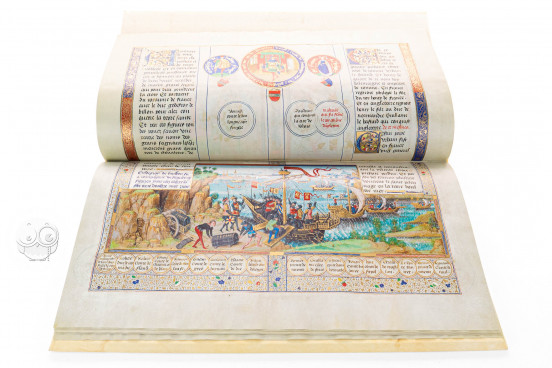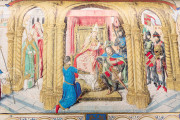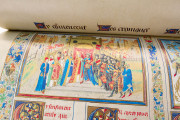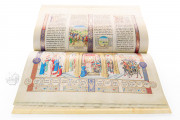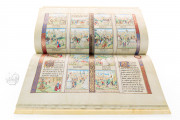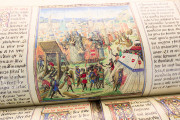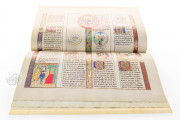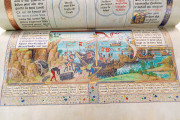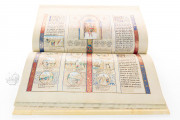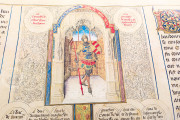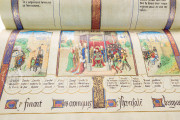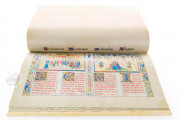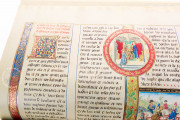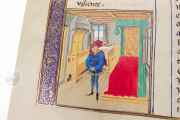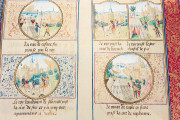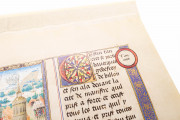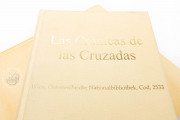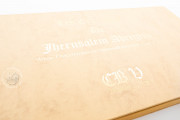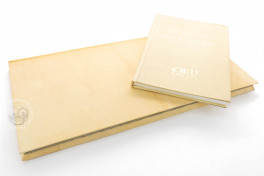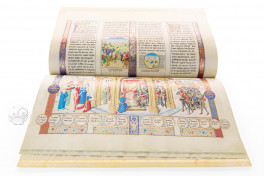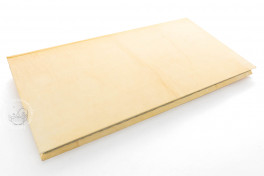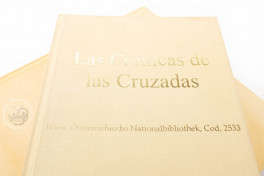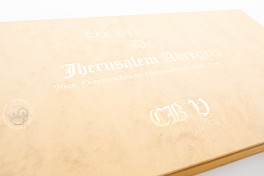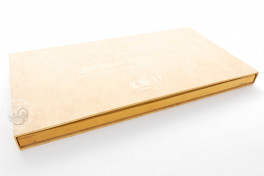The Chronicle of the Crusades is a superb example of Northern Renaissance illumination from the area between France and the Netherlands. Also known as Chroniques de Jerusalem abrégéés, it was written and illuminated around the second half of the 15th century. With its 11 large miniatures, 47 smaller miniatures, 98 medallions, and initials, this codex is attributed to the Girart Master and represents a masterpiece of Flemish book illustration.
The Story of the First Crusade
The manuscript tells the story of the First Crusade and the conquest of Jerusalem, focusing on the three crusader states, namely the kingdom of Jerusalem, the principality of Antioch, and the county of Edessa. The structure of the text is peculiar as it represents a complex parallel narrative recounted in four adjacent columns: the left one narrates the story of the county of Edessa, the two middle ones tell the main events and the genealogy of the kings of Jerusalem, and the right one focuses on the principality of Antioch.
Flemish Book Painting at Its Best
Much of the information on the story is contained in the iconographic apparatus in the form of captions and inscriptions in medallions. The decorative bands include gold and silver details, stylized foliage, gleaming gold-leaf ornamentation, flowers, and blue, red, and green fruits.
Full-page miniatures include rulers' portraits, ceremonies, and the scenes of the Crusade; smaller miniatures depict landscapes and portraits with superbly painted facial features.
Mastery of Detailed Landscapes and Perspective
The landscapes contain magnificent details, as in fol. 3r. where a large, horizontal miniature extends over four columns of text, depicting the start of the Crusades in 1096. The artist illustrated a lively scene taking place in a bay flanked by towering cliffs on one side and flat land on the other.
In the foreground, a ship lies at anchor while two commanders are conversing and two other figures, including the crusader Godfrey of Bouillon, Duke of Lower Lorraine (ca. 1060-1100), are already on board. Far off in the background are a city and more ships that are sailing towards the shore.
This miniature is an example of the sophisticated use of atmospheric perspective by the artist. Unfortunately, the identity of the artist remains unknown, although scholars have attributed the work to the Girart Master, to Jean Dreux, and to Philippe Mazerolles. The scribe of the work is thought to have belonged to the workshop of David Aubert.
A Superb Example of Gothic Cursiva Formata
The script of the Chronicle of the Crusades is a magnificent example of Burgundian Bastard. The shaft of letter d is lengthened and convex; the text features the Rücken -g or g with a back, with two vertical strokes making the upper lobe cross the upper horizontal stroke.
Life of the Manuscript
The codex, whose patron was Philip the Good, Duke of Burgundy, was kept at the Court of the Dukes of Burgundy until at least 1487. In 1517 it appeared in the records of Emperor Charles V of Germany and I of Spain. In 1619 it was mentioned in the inventory of Matthias, the third son of Maximilian II. On 20th December 1752, it was transferred from the Imperial Treasury of Vienna to the Court Library, Österreichische Nationalbibliothek, where it has been kept ever since.
We have 3 facsimiles of the manuscript "The Chronicle of the Crusades":
- Les Chroniques de Jérusalem facsimile edition published by Scriptorium, 2017
- Les Chroniques de Jerusalem Abregées facsimile edition published by Idion Verlag, 1980
- Les Chroniques de Jherusalem Abrégées facsimile edition published by Club Bibliófilo Versol, 2004

